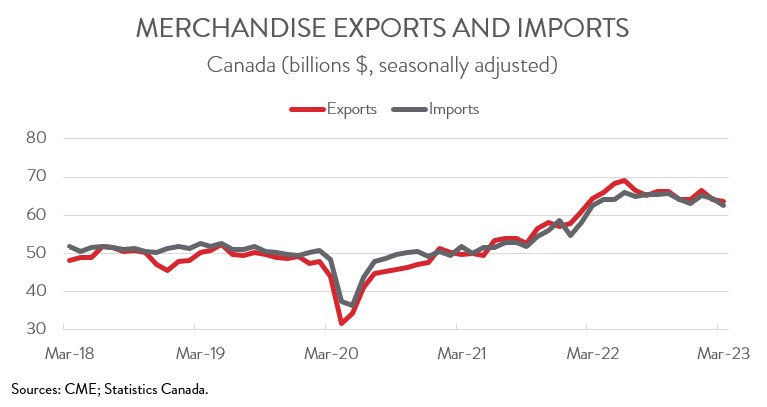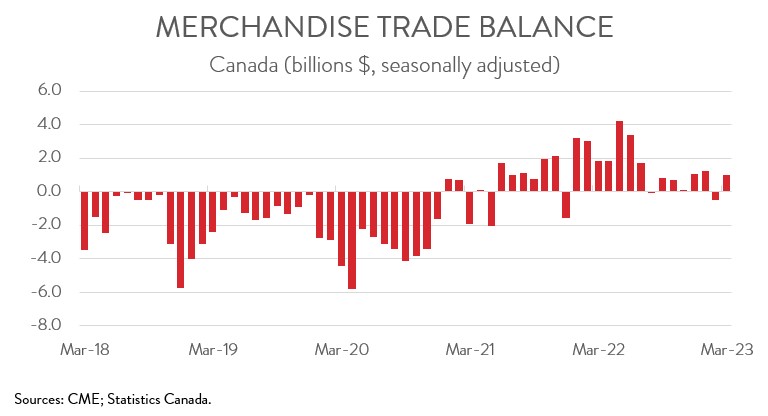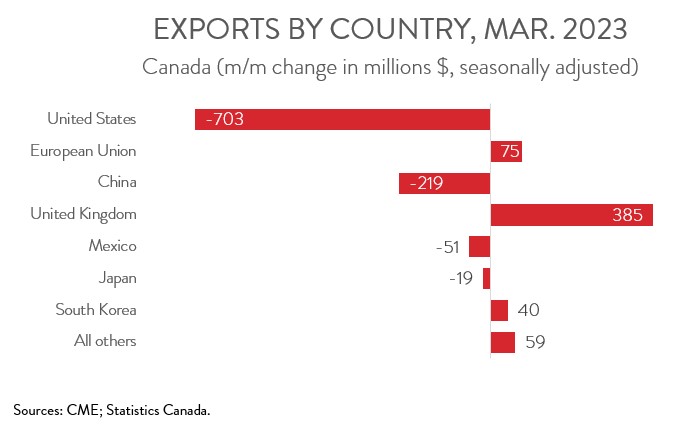International Trade
Merchandise Trade
March 2023
Merchandise Exports Fall in March on Lower Prices
HIGHLIGHTS
- Canadian merchandise exports fell 0.7% to $63.6 billion in March, while merchandise imports decreased 2.9% to $62.6 billion.
- Canada’s merchandise trade balanced improved from a deficit of $487 million in February to a surplus of $972 million in March.
- After removing price effects, export volumes were up 0.1% and import volumes were down 5.3%.
- The decrease in nominal exports spanned 7 of 11 product sections, led by declines in energy products, farm, fishing and intermediate food products, and forestry products and building and packaging materials.
- Exports to the U.S. contracted 1.5% to $47.8 billion in March, while exports to the rest of the world rose 1.7% to $15.8 billion.
- Export volumes jumped nearly 15% annualized in the first quarter, while import volumes edged down, indicating that net trade made a positive contribution to GDP growth in Q1. Over the near term, however, Canadian exports are expected to feel the pinch of slowing global economic growth, especially from south of the border.
EXPORTS AND IMPORTS BOTH DROP IN MARCH
Canadian merchandise exports fell 0.7% to $63.6 billion in March, the lowest level since February 2022. At the same time, merchandise imports decreased 2.9% to $62.6 billion, the lowest level observed since March 2022. The picture was more mixed in real or volume terms, with exports up 0.1% and imports down 5.3%.

Export volumes jumped nearly 15% annualized in the first quarter, while import volumes edged down, indicating that net trade made a positive contribution to GDP growth in Q1. Over the near term, however, Canadian exports are expected to feel the pinch of slowing global economic growth, especially from south of the border. That said, easing supply chain constraints and solid global demand for Canada’s natural resources should limit the slowdown in growth.
CANADA’S TRADE BALANCE SWINGS BACK TO A SUPRLUS
Canada’s merchandise trade balanced improved from a deficit of $487 million in February to a surplus of $972 million in March. Breaking the numbers down, our trade surplus with the U.S. narrowed from $8.3 billion in February to $7.6 billion in March, while Canada’s trade deficit with the rest of the world narrowed from $8.8 billion to $6.7 billion.

EXPORT DECLINE LED BY ENERGY PRODUCTS
The decrease in exports spanned 7 of 11 product sections. Exports of energy products fell the most, declining 5.9% to $13.3 billion in March, down for the ninth month in row. The drop was mainly attributable to lower exports of crude oil. While this was largely the result of lower prices, crude oil export volumes were also down on the month.
Elsewhere, exports of farm, fishing and intermediate food products decreased 5.3% to $5.6 billion, the first decline in three months. At the same time, exports of forestry products and building and packaging materials tumbled 6.4% to $4.1 billion, the lowest level observed since September 2021.
In more unwelcome news, exports of motor vehicles and parts declined for the second straight month, down 0.5% to $7.8 billion in March. Nevertheless, despite the decrease, this product section’s exports were up 16.7% on a year-over-year basis, as the supply of semiconductors and raw materials generally improves in the auto sector.
Declines in those product sections were partly offset by a surge in exports of aircraft and other transportation equipment and parts, up 30.8% to $2.5 billion in March. The increase was driven by a more than doubling of aircraft exports, particularly business jets to the U.S.

EXPORTS TO THE U.S. FALL FOR SECOND STRAIGHT MONTH
Exports to the U.S. fell 1.5% to $47.8 billion in March, down for the second month in a row. On the other hand, exports to the rest of the world increased 1.7% to $15.8 billion, partially recovering from a 7.0% decline in February. Among Canada’s major non-U.S. trading partners, exports to the U.K, the EU, and South Korea were up, while exports to China, Mexico, and Japan were down. Despite the decrease in March, Canada’s exports to China have risen 37.9% over the last 12 months.
